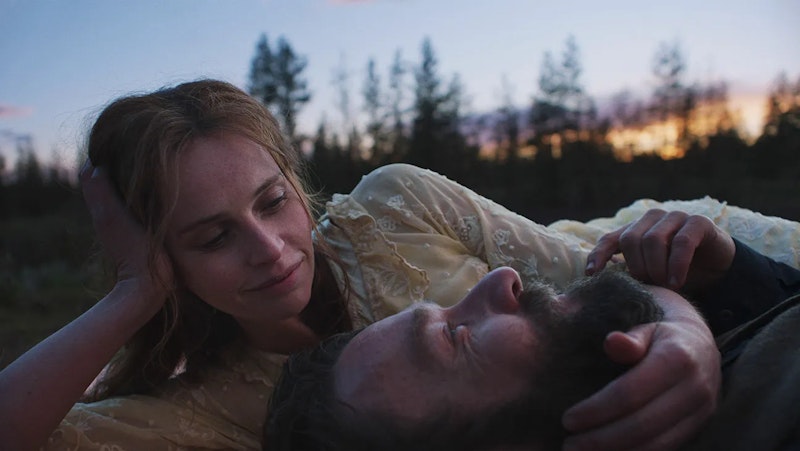Denis Johnson’s 2011 novel Train Dreams was praised because it captured a mystique and wonder to America’s heartland. Rather than broad declarations about its proximity to history, Train Dreams benefitted from the muted, often passive perspective of its main character, whose self-actualization was a microcosm of the everyman. Johnson’s short story collection Jesus’ Son was turned into a cult classic that starred Billy Crudup, but Train Dreams was a more significant literary achievement that required a more delicate touch.
The creative duo Greg Kwedar and Clint Bentley have written and produced several films together that they traded off directing. Bentley directed the contemporary western Jockey, a heartfelt, albeit slight independent production that featured a career-best performance from Clifton Collins Jr. Kwedar had a more significant solo venture with last year’s Sing Sing, a great prison drama that exemplified the necessity of the arts. Bentley’s the sole director of Train Dreams, but the film has combined the best efforts of both he and Kwedar’s previous efforts; while Train Dreams may find the same mythic beauty in America’s agrarian regions that Jockey did, it has the reflective wisdom that made Sing Sing so powerful.
Train Dreams is the story of the logger Robert Grainier (Joel Edgerton), whose life is transformed upon the discovery of a new love and a different source of employment. Robert’s engaged in a storybook romance with Gladys (Felicity Jones), a woman who shares his desire to build a home from scratch. However, the traditionalist profession that once kept Robert afloat has begun to dissipate upon the construction of national railroad systems, which employ workers from many walks of life. Although the presence of change is something Robert resists, he’s turned into yet another contributor to the manufacturing of railroads that consume the entire American frontier.
Train Dreams is bound to invoke comparisons to Terrence Malick, who took a similarly meditative approach to the open fields and modest homes of rural America in Badlands and Days of Heaven. Even if Bentley’s borrowed a few visual motifs that could’ve popped up on Malick’s shot list, he’s not as interested in the culmination of tragedy. There are some devastating moments in Train Dreams, but Bentley doesn’t see them as the result of a predetermined will of nature. Robert’s life was once beautiful because of its isolation, and it’s the connectivity of a national route of transformation that has deprived his life of wistfulness.
The most striking theme in Train Dreams is that the dawn of the 20th century was the last instance in which an individual could live without any real knowledge of the precedents set across the globe. News received by Robert about the goings-on in Washington D.C. are as removed from his reality as the fairy tales he’s told to his young daughter, who he and Gladys have comfortably raised on their own. Interaction with others was both inevitable and necessary in order to maintain some degree of comfortability and awareness, but the paths paved out for railroads seemed to literalize figurative connections to other communities. It's no coincidence that the deadliest moments of violence in Train Dreams are the result of technological leaps forward.
Edgerton is among the most underrated actors working today, and has become an ideal old-fashioned American leading man, despite being Australian. Given that Edgerton’s an accomplished director in his own right with the psychological thriller The Gift and the underrated conversion therapy drama Boy Erased, it's understandable why he was chosen for such a subdued role. Since Train Dreams is primarily composed of slice-of-life vignettes, it’s more important for a lead actor to maximize subtle expressions and finely-tuned physical adjustments to compliment the visual themes. There’s no instance in which Edgerton dominates a scene, which makes sense when considering Robert’s provincial perspective.
Edgerton has spent most of his career in smaller roles that linger in the background, even if he’s managed to out-act his more famous co-stars, which was the case in Black Mass and The Great Gatsby. His ability to disappear within a backdrop is a skill more self-aggrandizing stars wouldn’t be capable of because there’s no way that they would be believable as an ordinary person. The fear, exhaustion, and anticipation felt by Robert amidst the bastardization of the natural environment aren’t dramatically manipulative because Edgerton’s performance is so realistic.
Train Dreams does have an ensemble that includes many underappreciated character actors. William H. Macy is well-utilized as a crotchety explosive expert who’s given the chance to impart timeless wisdom to Robert when they’re briefly co-workers; it's hard to imagine another actor who could have such a significant impact on a film with such little screentime. There’s also a colorful performance by Paul Schneider as an apostle whose long-winded anecdotes are slightly irritating to Robert. Most audiences might recognize Schneider from Parks and Recreation, but he had his breakthrough in a similarly Malick-like place when he starred in David Gordon Green’s heartland romance All the Real Girls.
Train Dreams’ acquisition by Netflix is unfortunate for a film that doesn’t work as a second-screen experience. Theatrical exclusivity is often reserved for spectacle-based works like Superman or F1, but Train Dreams requires a degree of immersion that many Netflix subscribers won’t give it. What’s more concerning is how rarely Netflix has preserved its titles in physical media; given its subdued aesthetic, Train Dreams might be remembered even more after subsequent viewings.

